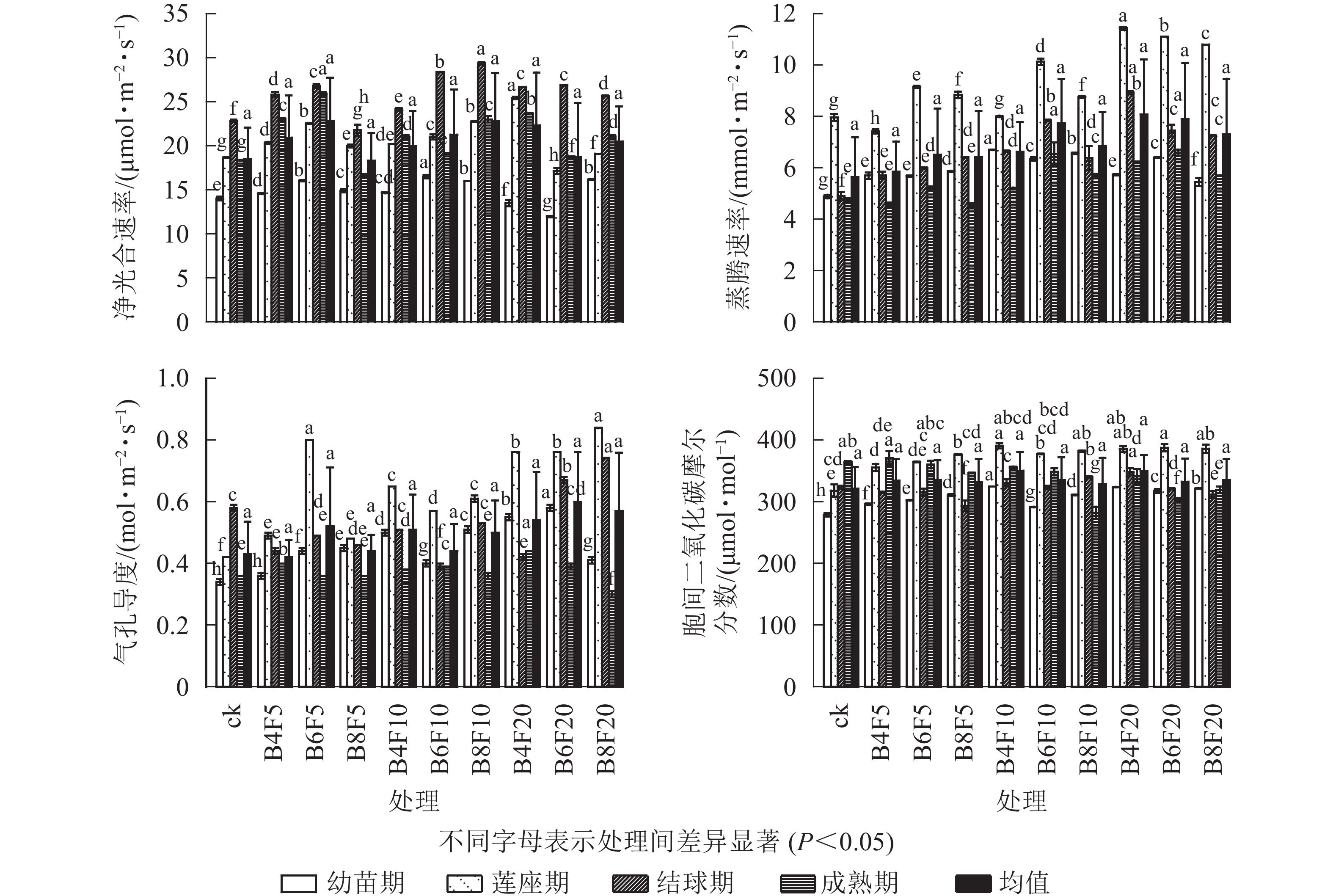-
紫甘蓝Brassica oleracea var. capitata f. rubra是十字花科Brassicaceae芸苔属Brassica结球甘蓝B. oleracea var. capitat的一个变型,是云南干热河谷农业区冬季特色优势农产品之一,具有适应性广、速生、早结丰产、保质期长、不易腐败和经济价值高等特点。紫甘蓝在元谋坝区种植面积较广。然而,随着当地化肥农药的大量施用,加之燥红壤黏粒较多,遇降雨土壤易板结,养分易流失,导致土壤肥力下降,影响作物的产量和品质。生物质炭是良好的土壤改良剂[1],施入土壤后会改变土壤性状,同时可作为缓释肥料载体,提高作物产量[2],近年来被广泛应用于农业生产领域。有机肥能为作物生长持续供应养分,同时能够改善土壤结构,保障蔬菜优质高产,是生产有机蔬菜不可替代的肥料[3]。有研究[4]表明:生物质炭与有机肥配施比单施更益于平邑甜茶Malus hupehensis幼苗的生长发育,更好地防控苹果Malus pumila连作障碍。李喜凤等[5]研究证明:生物质炭与有机肥配施可显著增强0~40 cm土壤总有机碳、颗粒有机碳、轻质有机碳、微生物量碳、易氧化有机碳和可溶性有机碳质量分数,有助于苹果成花,促进植株生长,提高产量。张毅博等[6]研究表明:生物质炭与有机肥的配施提高了土壤有机碳和全氮含量,从而改善土壤质地,提高土壤肥效。ARIF等[7]也研究发现:在低肥力碱性土壤中,生物质炭与有机肥的配施能显著提高磷素利用率,同时提高了玉米Zea mays-小麦Triticum aestivum的生产力和农田土壤质量。SÁNCHEZ-MONEDERO等[8]的研究结果显示:与单施生物质炭相比,生物质炭与有机肥(羊粪堆肥)混施使番茄Solanum lycopersicum果实质量增加16%,直径增加9%,硬度提高8%。目前,生物质炭与有机肥配施在经济果木和作物方面均有研究,但针对云南干热河谷坝区燥红壤改良和紫甘蓝生长的研究尚未见报道。鉴于此,本研究以元谋燥红壤为研究对象,紫甘蓝为供试材料,研究竹炭与有机肥配施对燥红壤土壤肥力及紫甘蓝光合特性、产量和品质的影响,以期获得元谋坝区紫甘蓝优质高产的配施策略,为生物炭在蔬菜生产应用中提供科学依据。
HTML
-
田间试验于2019年7−12月在云南省楚雄彝族自治州元谋县南城街150号热区生态研究所大田试验基地(25°41.5′N,101°52.6′E)进行。元谋属南亚热带干热季风气候,热量充足,年平均气温为21.9 ℃,年平均降水量613.8 mm,年日照时数2 670.4 h,无霜期302~331 d。
-
供试土壤燥红壤(0~20 cm)基本理化性质为pH 6.60,有机质6.30 g·kg−1,全氮0.65 g·kg−1,全磷2.20 g·kg−1,全钾17.22 g·kg−1,速效磷10.67 mg·kg−1,速效钾108.41 mg·kg−1。
供试紫甘蓝品种为普罗米悠‘Puluomiyou’,是元谋干热河谷地区主要种植的紫甘蓝品种,其生长期约100~120 d,为云南省农业科学院热区生态农业研究所提供。
供试生物质炭为竹炭,购于福建优选炭业有限责任公司。其以竹材经450~480 ℃温度炭化1 h而成。竹炭pH为11.31,有机碳质量分数为860.60 g·kg−1,全氮10.30 g·kg−1,平均孔径为2.654 43 nm。
供试有机肥为当地农户常用的经羊粪发酵产生的堆肥,其pH为7.63,氮、五氧化二磷、氧化钾质量分数分别为46.00、14.50、9.80 g·kg−1。
-
采用3×3完全方案设计,设置竹炭用量3个水平,有机肥用量3个水平,加上空白对照(ck),共计10个处理(表1)。每个处理3次重复。
处理代号 竹炭(B)/% 有机肥(F)/(t·hm−2) 处理代号 竹炭(B)/% 有机肥(F)/(t·hm−2) 对照 0 0 B6F10 6 10 B4F5 4 5 B8F10 8 10 B6F5 6 5 B4F20 4 20 B8F5 8 5 B6F20 6 20 B4F10 4 10 B8F20 8 20 Table 1. Design of field experiment
试验地总面积为600 m2,每个小区面积为20 m2(4 m×5 m),每个处理3个重复,共30个小区。于2019年7月用旋耕机将小区土壤翻匀晾晒,并用铁板将各小区隔开。7月末按照试验设计将生物质炭和有机肥一次性施入小区(随机组合),并再次将土壤翻匀(土肥厚度约30 cm)。9月5日种植长势均一株高为6.57~7.50 cm紫甘蓝幼苗,株距为30.00 cm,行距为20.00 cm,并覆膜,保持充分灌水,后期隔3 d灌水1次。在9月底和10月底进行追肥(每个小区追施尿素300 g,磷酸二氢钾140 g),促进紫甘蓝幼苗期和莲座期生长。试验灌溉方式为地表滴灌,每株幼苗1个滴头,滴头设置在同一侧,滴头与幼苗的距离约为3 cm,滴头间距与株距相同。期间管理方式按当地方式管理。
-
土壤:2019年12月底紫甘蓝采收后,在每个小区采用5点取样法采集0~20 cm土层土样,并将每个处理混匀带回实验室风干。一部分过1.00 mm筛,装自封袋用于土壤pH和速效成分的测定;另一部分过0.25 mm筛,装自封袋用于土壤有机质、全磷和全钾质量分数的测定。土壤理化性质参照文献[9]测定。其中,土壤pH采用pH酸度计(PHS-3C,PHS-4C 型)测定;土壤有机质质量分数采用油浴加热-重铬酸钾氧化容量法测定;全磷采用高氯酸消解-钼锑抗比色法测定;土壤有效磷采用Brayl 法(0.025~0.030 mol·L−1,氟化铵)浸提剂测定;全钾和速效钾均使用电感耦合等离子体发射光谱仪(ICP)测定。
光合特性:定期观测紫甘蓝生长状况,于每月月底选择晴朗天气在11:00−16:00采用Li-6400Xt测定紫甘蓝不同生长时期(幼苗期、莲座期、结球期、成熟期)叶片的净光合速率、蒸腾速率、气孔导度和胞间二氧化碳摩尔分数。
产量和品质:12月底紫甘蓝收获后称量,记录每个小区紫甘蓝产量,并在每个小区选取长势基本一致的10株,去掉外叶,进行维生素C、还原糖、可溶性蛋白质和花青素等品质分析。其中:可溶性蛋白质采用考马斯亮蓝G-250染色法测定,维生素C采用2,6-二氯酚靛比色法,还原糖采用3,5-二硝基酚水杨酸比色法测定,花青素采用质量分数为1%盐酸浸提比色法测定[10]。
-
数据采用Excel 2016进行整理,使用Origin 2017作图,采用SPSS 21.0统计分析软件进行双因素方差分析和多重比较,用Duncan法比较处理间的差异显著性(P<0.05)。
1.1. 试验地概况
1.2. 试验材料
1.3. 试验设计
1.4. 测定方法
1.5. 数据处理
-
由图1可知:竹炭与有机肥配施对紫甘蓝地土壤pH以及有机质、全磷、有效磷、全钾和速效钾质量分数均具有不同程度的影响。与对照相比,竹炭与有机肥配施能显著提高土壤速效钾质量分数(P<0.05),同时高量有机肥与竹炭配施显著提高了土壤有效磷质量分数(P<0.05)。其中,pH以B8F10处理最高;有机质和全钾以B4F10处理最高,分别提高了107.93%和46.06%;全磷以B8F5处理最高,提高了58.67%;有效磷以B6F20处理最高,提高了157.44%;速效钾以B8F20最高,提高了226.60%。
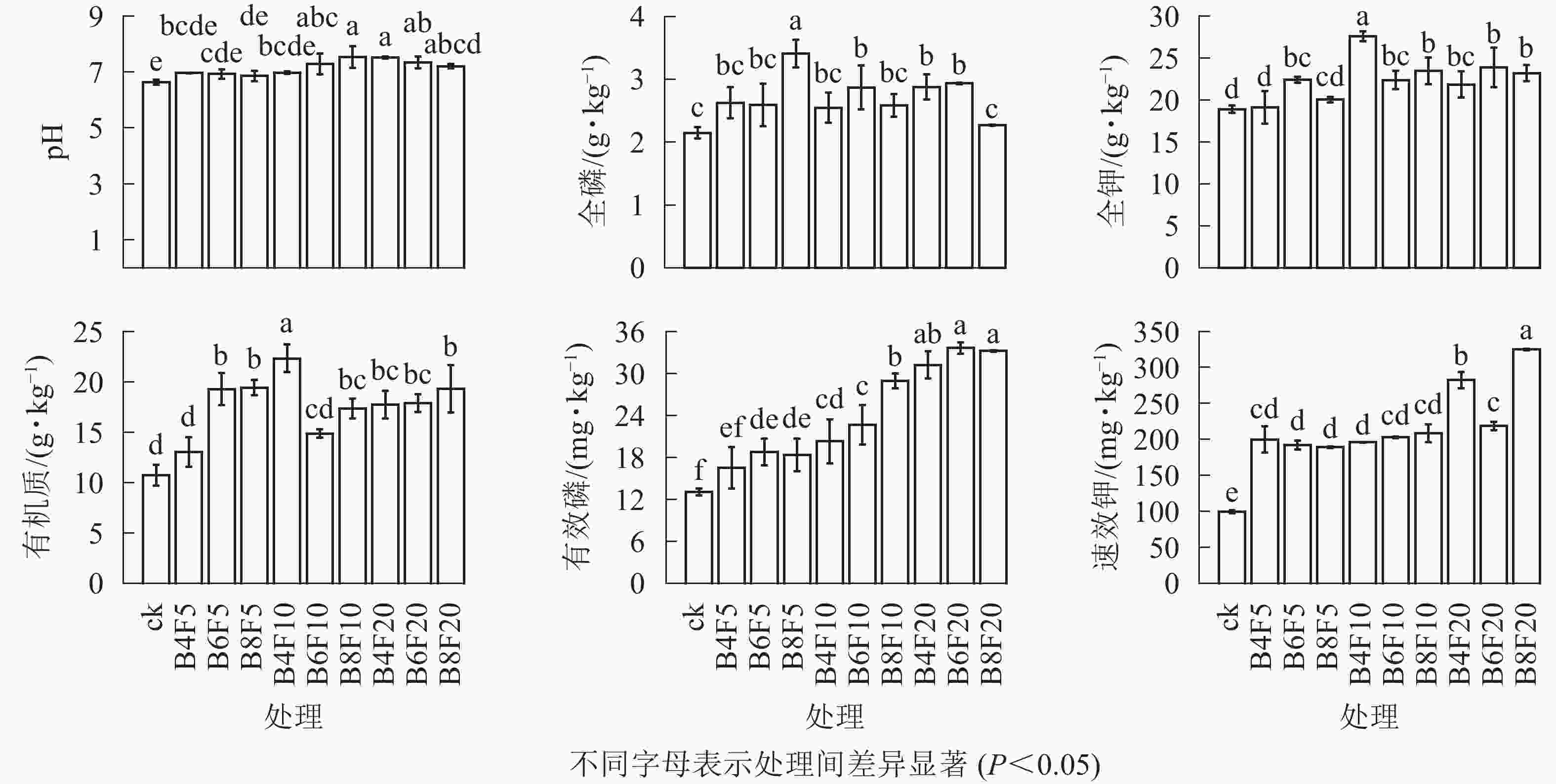
Figure 1. Effects of bamboo charcoal and organic fertilizer application on soil physical and chemical properties
在5 t·hm−2有机肥用量条件下,土壤有机质和全磷质量分数随竹炭比例的增加而增加,全钾和有效磷以B6F5处理较高,而对速效钾无显著影响(P>0.05)。在10 t·hm−2有机肥用量下,土壤有机质和全钾质量分数以B4F10处理较高,全磷以B6F10处理较高,高比例竹炭的施用反而降低了土壤有机质和全磷质量分数,有效磷和速效钾质量分数随竹炭量的增加而增加,但对速效钾影响不显著。在20 t·hm−2有机肥用量下,土壤速效养分(有效磷和速效钾质量分数)均较高,有机质质量分数随竹炭比例的增加而增加,全磷、全钾和有效磷以B6F20处理最高,速效钾以B8F20处理最高。而在同一有机肥用量下,各处理间土壤pH均无显著差异(P>0.05)。
-
由图2可知:与对照相比,除紫甘蓝幼苗期外,竹炭和有机肥配施后紫甘蓝各生长时期的净光合速率、蒸腾速率、气孔导度和胞间二氧化碳摩尔分数总体上有提高趋势。紫甘蓝叶片净光合速率从幼苗期到结球期不断增大,在结球期达到顶峰,成熟期逐渐减弱;叶片蒸腾速率和气孔导度(除对照外)在莲座期最大,结球期和成熟期逐渐减弱;除对照和B4F5处理外,叶片胞间二氧化碳摩尔分数在莲座期达到最大,紫甘蓝叶片光合作用从幼苗期到结球期逐渐增强,而成熟期逐渐减弱。与对照相比,除B8F5处理外,竹炭与有机肥配施对紫甘蓝叶片4个时期净光合速率均值提高了1.14%~23.54%;竹炭与有机肥配施对紫甘蓝叶片4个时期蒸腾速率和胞间二氧化碳摩尔分数均值较对照分别提高了3.01%~43.52%和2.33%~9.11%;除B4F5处理外,竹炭与有机肥配施对紫甘蓝叶片4个时期气孔导度均值较对照处理提高了2.33%~39.54%。
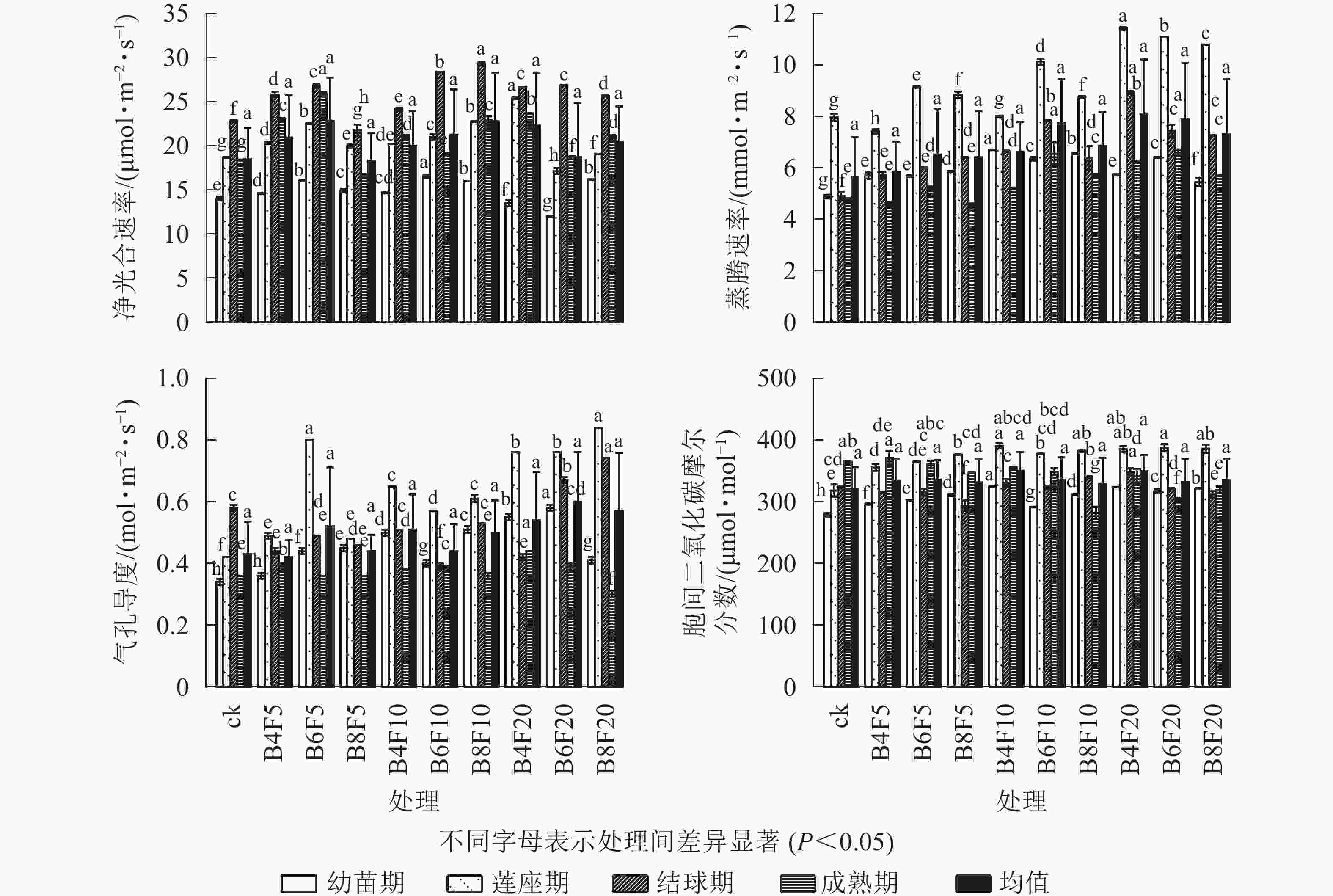
Figure 2. Effects of bamboo charcoal and organic fertilizer application on daily averaged photosynthetic characteristics of B. oleracea var. capitata f. rubra
在5 t·hm−2有机肥用量下,B6F5处理各时期叶片净光合速率、蒸腾速率和气孔导度均能维持较高水平,与另外2个处理相比,叶片净光合速率、蒸腾速率和气孔导度分别增加了9.08%~24.55%、1.56%~11.28%和18.18%~23.81%,而对叶片胞间二氧化碳摩尔分数无显著差异。在10 t·hm−2有机肥用量下,各时期叶片净光合速率随竹炭比例的增加而增加,与B4F10相比,B6F10和B8F10处理的净光合速率均值分别提高了6.30%和13.84%;叶片蒸腾速率以B6F10处理较高,较B4F10和B8F10处理分别提高了16.44%和12.70%,而对叶片气孔导度和胞间二氧化碳摩尔分数无显著性差异。在20 t·hm−2有机肥用量下,叶片净光合速率、蒸腾速率和胞间二氧化碳摩尔分数随竹炭量的增加而呈减弱趋势,B6F20和B8F20较B4F20处理对叶片净光合速率、蒸腾速率和胞间二氧化碳摩尔分数分别降低了8.93%~19.48%、2.41%~10.68%和4.48%~5.16%,而叶片气孔导度则以B6F20处理较高,较B4F20和B8F20处理分别提高了11.11%和5.26%。
-
与对照相比,竹炭与有机肥配施均不同程度提高了紫甘蓝产量且各处理间表现不同,增产幅度为9.28%~58.11%,其中以B6F10处理下紫甘蓝产量最高,其次为B8F10处理,紫甘蓝产量分别较对照提高了58.11%和44.16%(图3)。当有机肥用量为5和20 t·hm−2时,紫甘蓝产量随竹炭用量的增加呈现下降的趋势;当有机肥用量为10 t·hm−2时,紫甘蓝产量以B5F10处理较高,但处理间差异不显著(P>0.05)。综合来看,10 t·hm−2有机肥用量下添加6%竹炭处理对紫甘蓝增产效果最佳。
-
图4显示:与对照相比,竹炭与有机肥配施均提高了紫甘蓝维生素C、还原糖、可溶性蛋白质和花青素质量分数。紫甘蓝中维生素C、还原糖、可溶性蛋白质和花青素质量分数分别提高了13.79%~33.29%、0.06%~11.17%、5.44%~27.97%和8.00%~33.88%,其中维生素C、还原糖、可溶性蛋白质和花青素质量分数分别以B4F10、B8F5、B6F10、B6F10处理下最高。在同一有机肥用量条件下,各处理间紫甘蓝中维生素C、还原糖、可溶性蛋白质和花青素质量分数无显著差异(P>0.05),其中,在5 t·hm−2有机肥用量下,维生素C和花青素质量分数以B6F5处理较高,还原糖随竹炭量的增加略有增加,可溶性蛋白质以B4F5处理较高;在10 t·hm−2有机肥用量下,维生素C质量分数随竹炭比例的增加而略微有下降的趋势,可溶性蛋白质和花青素质量分数以B6F10处理较高,还原糖无显著差异;在20 t·hm−2有机肥用量下,维生素C、可溶性蛋白质和花青素质量分数以B6F20处理较高,而还原糖随竹炭比例的增加而降低。
-
本研究土壤样品采集于紫甘蓝成熟期,因此,采用土壤基本理化性质、成熟期的紫甘蓝光合特性指标和产量及品质进行双因素和单因素方差分析。表2显示:竹炭添加比例对土壤速效钾、土壤全磷、有效磷质量分数和紫甘蓝光合特性有极显著影响(P<0.01),对紫甘蓝还原糖和花青素质量分数有显著影响(P<0.05);有机肥用量对土壤pH、全磷、有效磷、全钾、速效钾质量分数及紫甘蓝净光合速率、蒸腾速率、胞间二氧化碳摩尔分数、产量和紫甘蓝还原糖、可溶性蛋白质质量分数有极显著影响(P<0.01),对土壤有机质、紫甘蓝维生素C和花青素质量分数具有显著影响(P<0.05);除土壤pH外,竹炭与有机肥的交互效应对土壤pH具有显著影响(P<0.05);对土壤其他理化性质、紫甘蓝光合特性和还原糖质量分数均具有极显著影响(P<0.01),而各处理对紫甘蓝可溶性蛋白质有显著影响(P<0.05),对土壤理化性质和紫甘蓝光合特性、产量及其维生素C、还原糖、花青素均具有极显著的影响(P<0.01)。
参数 双因素 单因素处理 竹炭 有机肥 竹炭×有机肥 pH 0.869 <0.001*** 0.017* <0.001*** 有机质 0.419 0.011* <0.001*** <0.001*** 全磷 0.001** <0.001*** <0.001*** <0.001*** 有效磷 0.001** <0.001*** <0.001*** <0.001*** 全钾 0.522 <0.001*** <0.001*** <0.001*** 速效钾 <0.001*** <0.001*** <0.001*** <0.001*** 净光合速率 <0.001*** <0.001*** <0.001*** <0.001*** 蒸腾速率 <0.001*** <0.001*** <0.001*** <0.001*** 气孔导度 <0.001*** 0.902 <0.001*** <0.001*** 胞间二氧化碳摩尔分数 <0.001*** <0.001*** <0.001*** <0.001*** 产量 0.081 <0.001*** 0.199 <0.001*** 维生素C 0.335 0.029* 0.334 0.005** 还原糖 0.041* 0.001** <0.001*** <0.001*** 可溶性蛋白质 0.807 0.003** 0.853 0.035* 花青素 0.027* 0.045* 0.203 0.006** 说明:*、**和***分别表示在0.05、0.01和0.001水平上差异显著 Table 2. Analysis of variance (P-values)
2.1. 竹炭与有机肥配施对土壤基本理化性质的影响
2.2. 竹炭与有机肥配施对紫甘蓝光合特性的影响
2.3. 竹炭与有机肥配施对紫甘蓝产量的影响
2.4. 竹炭与有机肥配施对紫甘蓝品质的影响
2.5. 方差分析
-
紫甘蓝适宜生长环境趋向于中性[11]。本研究中竹炭(pH 11.31)和有机肥(pH 7.63)呈碱性,与对照 (pH 6.63)相比,各竹炭与有机肥配施处理均不同程度地提高了土壤pH,使土壤趋于中性。本研究发现:竹炭与有机肥配施能显著提高土壤有机质、有效磷和速效钾质量分数,同时提高土壤全磷和全钾质量分数。其原因可能是生物质炭和有机肥之间存在互作效应[12],生物质炭通过与有机矿物的相互作用,形成有机-矿物复合物,促进有机肥中碳的稳定,增加土壤有机质质量分数;生物质炭的施用能抑制土壤中氮磷的淋失[13],有机肥也能够对氮磷进行补偿[14],从而提高了土壤氮磷养分含量,弥补生物质炭本身的养分亏缺,两者具有一定的协同作用[15]。竹炭与有机肥配施还提高了土壤中全钾和速效钾质量分数,这与贺丽群等[16]的研究结果相似。总之,从对土壤肥力性状的作用方式来看,生物质炭与有机肥配施对土壤具有一定的互补性,两者通过同化作用[17-19],改善了作物对于养分的吸收及转运,促进作物对土壤营养元素的吸收。
-
本研究表明:竹炭与有机肥配施提高了紫甘蓝各时期净光合速率、蒸腾速率和气孔导度,这说明竹炭与有机肥配施有利于改善紫甘蓝生长的生理活性强度[20],增强对外界二氧化碳的捕获,导致光合作用强度增大。这可能是因为有机肥的施用可增强植物的光合性能[21],竹炭添加提高了有机肥的利用效率,且高量(20 t·hm−2)或中量(10 t·hm−2)有机肥中添加4%或6%竹炭更利于提高紫甘蓝光合特性,提高有机物质的积累,增大光合作用强度。有机肥的施用可延缓叶片的衰老,增强叶片的光合作用和抗逆性[22],同时,有机肥的施用可提高叶绿素含量,使得叶片叶肉细胞光合作用活性增加[23],进而导致紫甘蓝光合作用强度增加。此外,竹炭与有机肥的配施为紫甘蓝生长提供了更多的养分。
-
大多研究结果显示:生物质炭与有机肥配施使作物增产效果更佳,更益于植物的生长。应金耀等[24]研究表明:生物质炭与有机肥配合施用使青菜Brassica chinensis产量高于单施生物炭处理,在促进蔬菜生长方面优于其他处理。本研究显示:竹炭与有机肥配施处理的紫甘蓝产量均高于对照,其中施用10 t·hm−2的有机肥下添加6%生物质炭增产效果更佳,较对照增产58.11%,这与LI等[25]研究结果类似。生物质炭与有机或无机肥料配合施用,作物增产效果更佳[26]。韩晓亮等[27]研究表明:适量生物质炭的施用可提高根系代谢活动,确保作物稳定增产,在一定程度上可促进作物产量的积累,进而提高作物长势。但也有不一致的研究结果,表明生物质炭与无机或有机肥料配施可能受多种因素的影响,包括土壤类型、生物质炭种类、气候条件[28]、施用量和作物种类[29]等,导致生物质炭与有机或无机肥料配合施用的增产效应不同。
-
紫甘蓝含有丰富的维生素C、还原糖、可溶性蛋白质、花青素等营养物质[30],施用有机肥(粪便、秸秆等)有利于提高养分的利用效率[31],促进紫甘蓝对养分的吸收,从而改善紫甘蓝品质。生物质炭与有机肥的配施能提高农作物品质,如张宇等[32]研究发现:氮肥减量60%和有机肥增加40%基础上添加生物质炭提高了大蒜Allium sativum 鳞茎及蒜薹中的游离氨基酸含量、可溶性糖及蔗糖含量;易洪海等[33]研究表明:生物质炭与有机肥配合施用使藜蒿Artemisia selengensis中维生素C、可溶性糖、可溶性蛋白质分别增加4.80%~6.40%、1.86%~3.65%、0.74%~2.22%。本研究中,与对照相比,竹炭与有机肥配施均提高了紫甘蓝维生素C、还原糖、可溶性蛋白质和花青素质量分数,提高幅度分别为13.79%~33.29%、0.06%~11.17%、5.44%~27.97%和8.00%~33.88%,这可能是因为有机肥提高了土壤养分含量,尤其速效钾和全钾为紫甘蓝生长所必需的营养成分。双因素方差分析显示:有机肥对紫甘蓝品质具有极显著或显著影响,适量有机肥与生物质炭配施可以促进农作物生长发育,提高蔬菜品质[34]。本研究结果显示:6%竹炭与中量(10 t·hm−2)有机肥配施对紫甘蓝可溶性蛋白质和花青素质量分数提升效果更佳,且产量较高。这可能是因为生物质炭孔隙发达,有机肥肥效长,可为紫甘蓝的生长持续供应养分。
3.1. 竹炭与有机肥配施对土壤基本理化性质的影响
3.2. 竹炭与有机肥配施对紫甘蓝光合特性的影响
3.3. 竹炭与有机肥配施对紫甘蓝产量的影响
3.4. 竹炭与有机肥配施对紫甘蓝品质的影响
-
与对照相比,竹炭与有机肥配施提高了土壤pH,同时提高了有机质、全磷、有效磷、全钾和速效钾质量分数;提高了紫甘蓝叶片除幼苗期外其他时期净光合速率、蒸腾速率、气孔导度和胞间二氧化碳摩尔分数;总体上提高了紫甘蓝产量,同时提高了紫甘蓝维生素C、还原糖、可溶性蛋白质、花青素质量分数。从紫甘蓝增产效益来看,添加6%竹炭与10 t·hm−2的有机肥为最佳施肥配比,该处理下紫甘蓝可溶性蛋白质和花青素质量分数最高。竹炭、有机肥、竹炭与有机肥的交互效应对土壤养分质量分数与紫甘蓝叶片光合特性指标、产量、品质有极显著或显著的影响,竹炭与有机肥配施为紫甘蓝生长持续供应养分,促进紫甘蓝生长,提高紫甘蓝产量和品质。




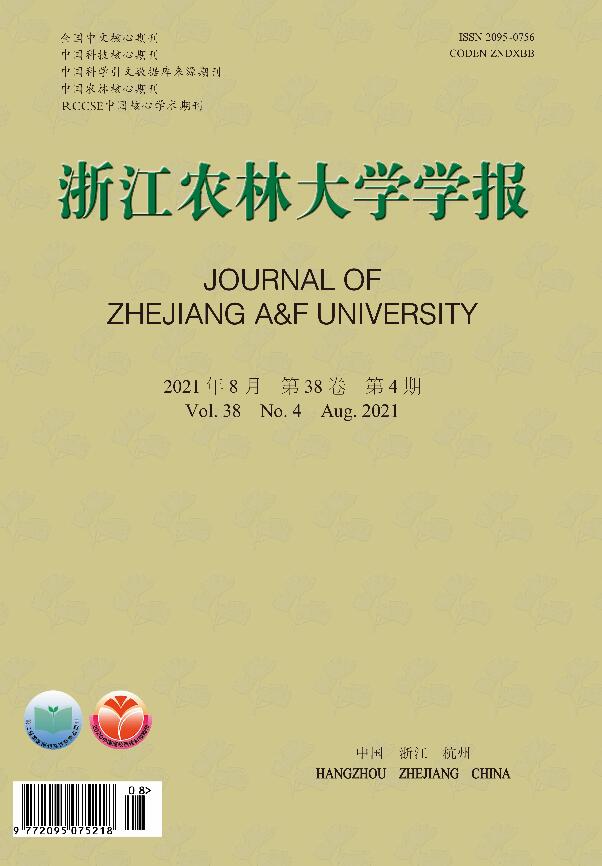


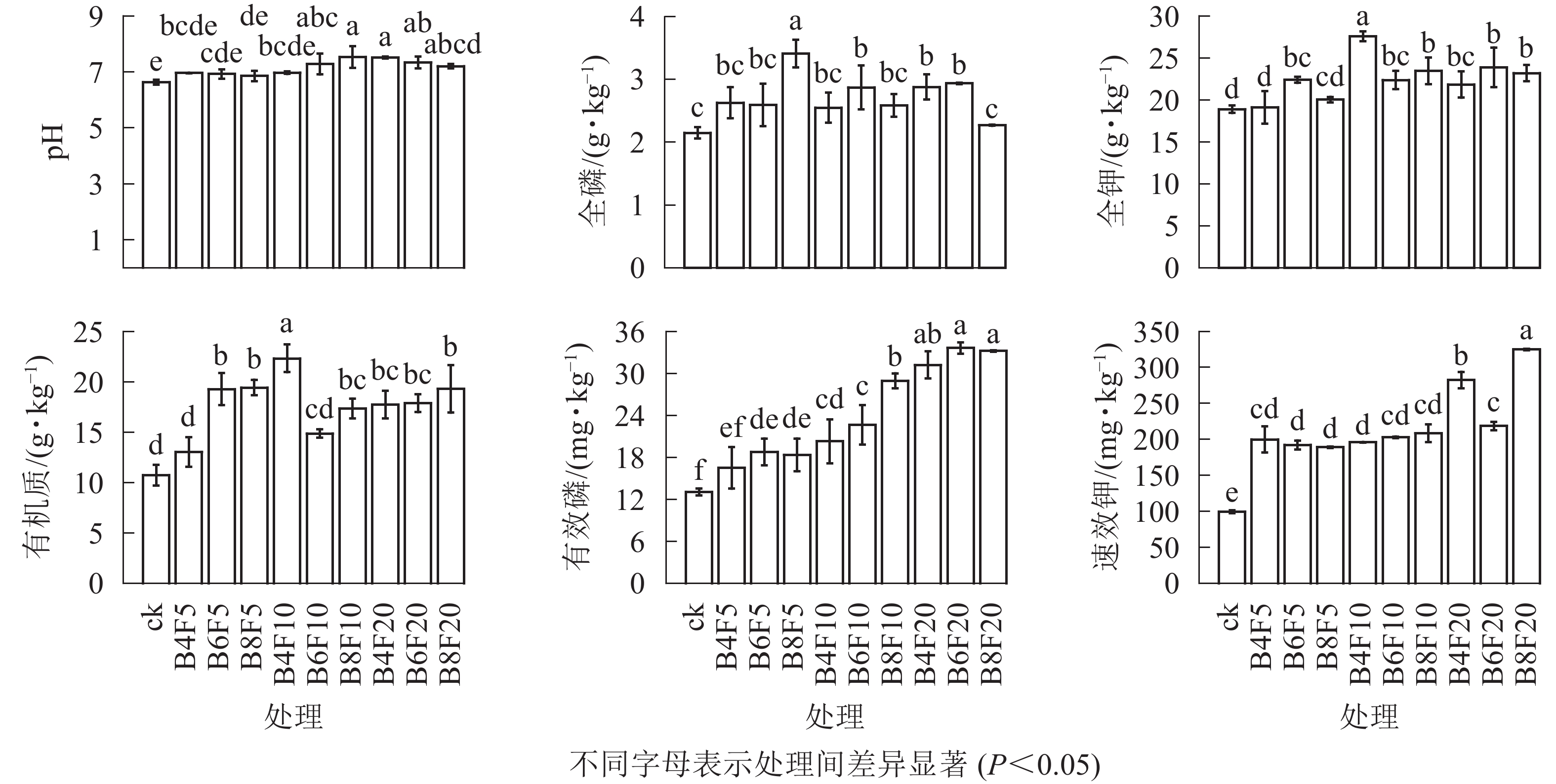


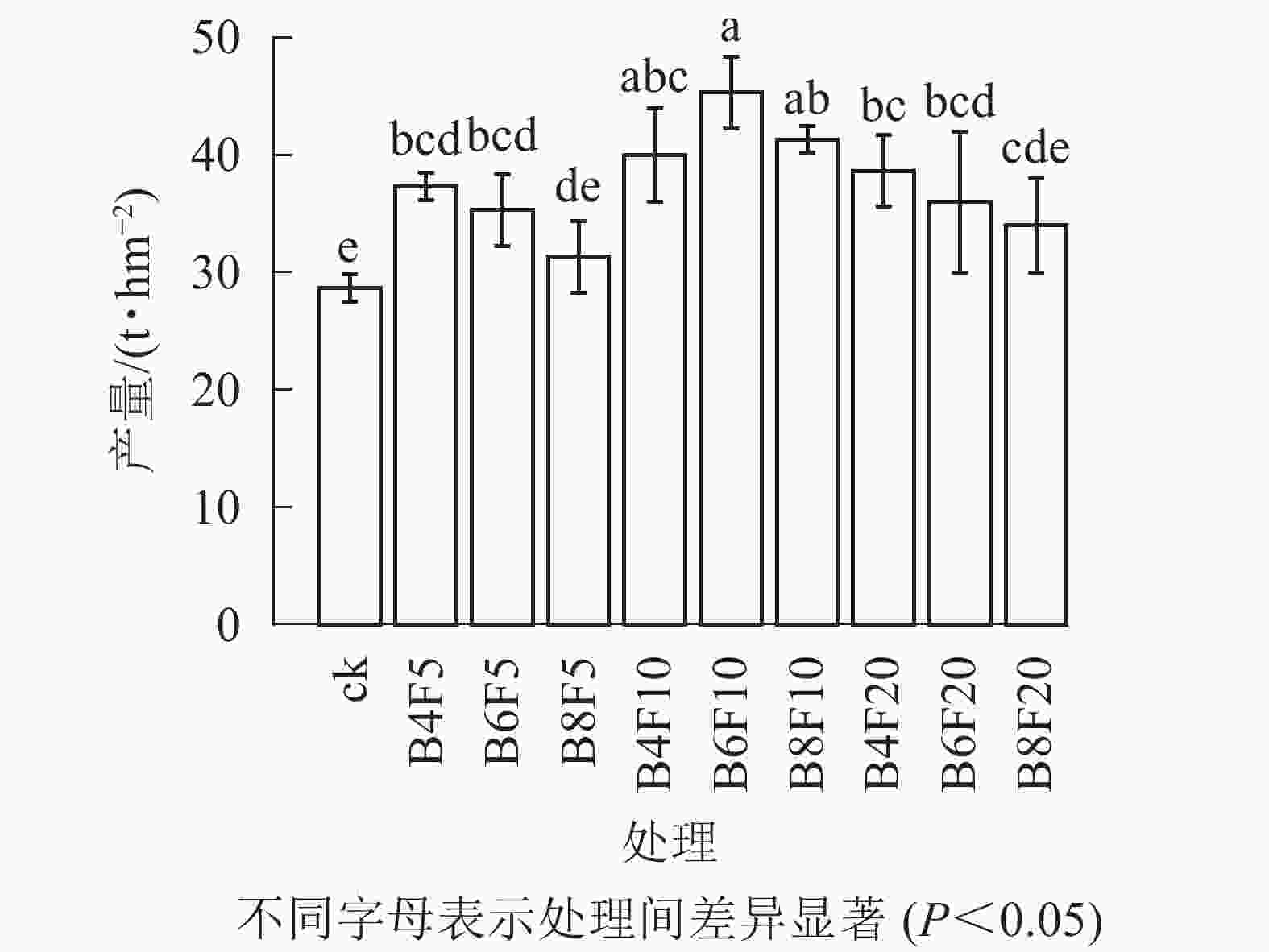
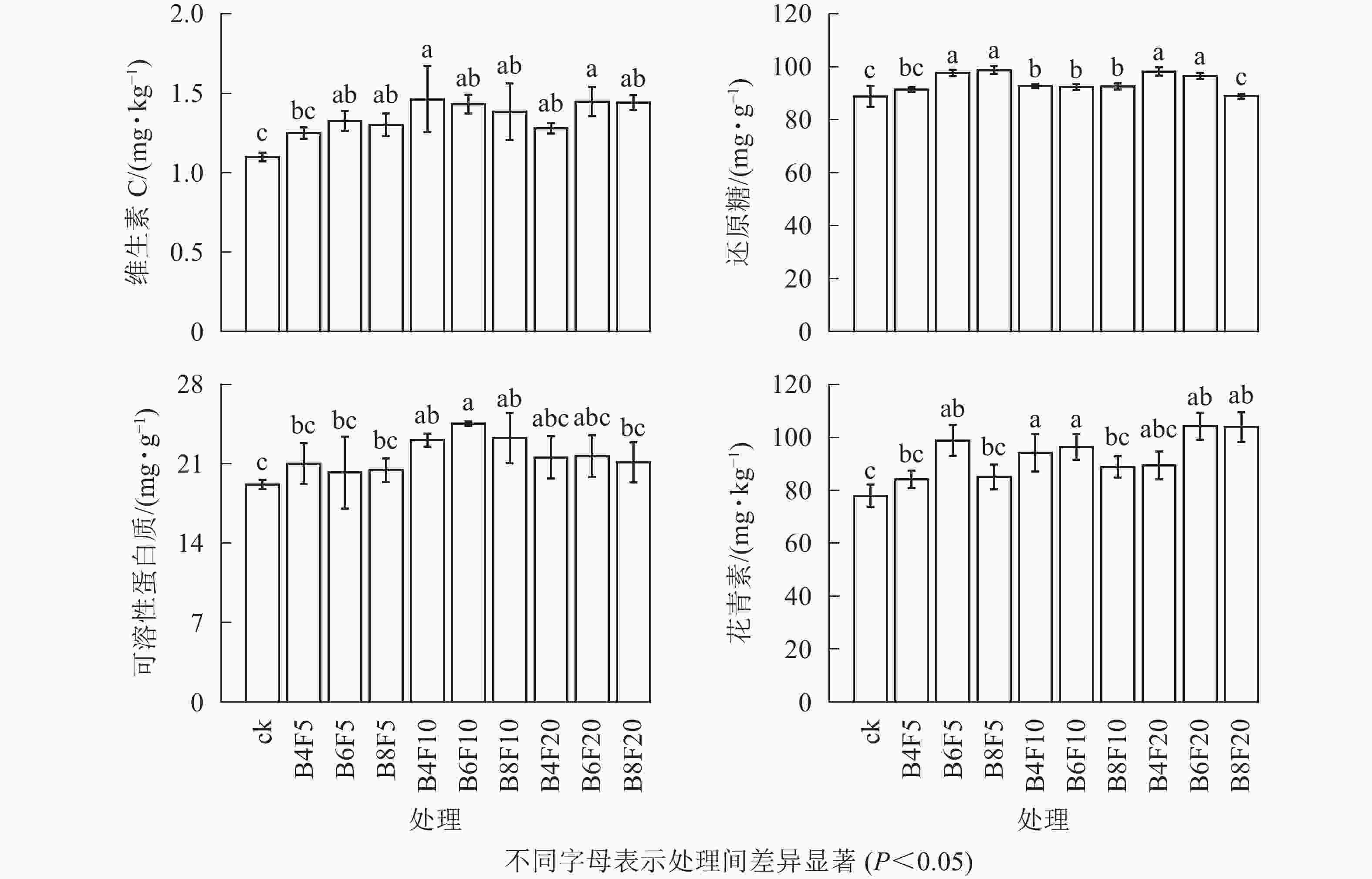
 DownLoad:
DownLoad:
